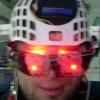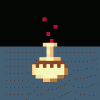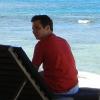some theory about my methods: copy/paste style from some web because language barier its very hard for me write long text.
this is only little peace whole is far more complex few hundred of
pages of theory
Stress and fear reaction
When the brain receives a sensory stimulus indicating a danger, it is
routed first to the thalamus. From there, the information is sent out
over two parallel pathways: the thalamo-amygdala pathway (the “short
route”) and the thalamo-cortico-amygdala pathway (the “long route”).
The short route conveys a fast, rough impression of the situation,
because it is a sub-cortical pathway in which no cognition is
involved. This pathway activates the amygdala which, through its
central nucleus, generates emotional responses before any perceptual
integration has even occurred and before the mind can form a complete
representation of the stimulus.
Subsequently, the information that has travelled via the long route
and been processed in the cortex reaches the amygdala and tells it
whether or not the stimulus represents a real threat. To provide this
assessment, various levels of cortical processing are required.
First, the various modalities of the perceived object are processed
by the primary sensory cortex. Then the unimodal associative cortex
provides the amygdala with a representation of the object. At an even
higher level of analysis, the polymodal associative cortex
conceptualizes the object and also informs the amygdala about it. This
elaborate representation of the object is then compared with the
contents of explicit memory by means of the hippocampus, which also
communicates closely with the amygdala.
The hippocampus is the structure that supports the explicit memory
required to learn about the dangerousness of an object or situation in
the first place. The hippocampus is also especially sensitive to the
encoding of the context associated with an aversive experience. It is
because of the hippocampus that not only can a stimulus become a
source of conditioned fear, but so can all the objects surrounding it
and the situation or location in which it occurs.
The imminent presence of a danger then performs the task of activating
the amygdala, whose discharge patterns in turn activate the efferent
structures responsible for physical manifestations of fear, such as
increased heart rate and blood pressure, sweaty hands, dry mouth, and
tense muscles.
----
Major connections to the the amygdala also come from the medial
prefrontal cortex. These connections appear to be involved in the
process of extinction, whereby a stimulus that triggers a conditioned
fear gradually loses this effect. This happens if that stimulus is
repeatedly presented to the subject without the unconditional
nociceptive stimulus that was initially associated with it to produce
the conditioned fear.
The prefrontal cortex also seems to be involved in the final phase of
confronting a danger, where, after the initial automatic, emotional
reaction, we are forced to react and choose the course of action that
can best get us out of danger. In people whose frontal cortex is
damaged (people with “frontal syndrome"), planning the slightest task
is very difficult, if not impossible.
Thus, the
ability that our superior mental structures give us to
voluntarily plan an emotional response suited to the situation is a
wonderful complement to our system of rapid, automatic responses. The
connections from the prefrontal cortex to the amygdala also enable us
to exercise a certain conscious control over our anxiety. However, at
the same time, this faculty can create anxiety by allowing us to
imagine the failure of a given scenario or even the presence of
dangers that do not actually exist.
---
Though
depression involves an overall reduction in brain activity,
some parts of the brain are more affected than others. In brain-
imaging studies using PET scans, depressed people display abnormally
low activity in the prefrontal cortex, and more specifically in its
lateral, orbitofrontal, and ventromedial regions. And the severity of
the
depression often correlates with the extent of the decline in
activity in the prefrontal cortex.The prefrontal cortex is known not only to be involved in
emotional
responses, but also to have numerous connections with other parts of
the brain that are responsible for controlling dopamine,
norepinephrine, and serotonin, three neurotransmitters that are
important in mood regulation. More specifically, the lateral
prefrontal cortex seems to help us choose a course of behaviour by
letting us assess the various alternatives mentally. The orbitofrontal
cortex seems to let us defer certain immediate gratifications
and
suppress certain emotions in order to obtain greater long-term
benefits. And the ventromedial cortex is thought to be one of the
sites in the brain where we experience emotions and the meanings of
things.
1) orbitofrontal cortex
2) lateral prefrontal cortex
3) ventromedial cortex
4) limbic system
The two halves of the
prefrontal cortex also seem to have specialized
functions, with the left half being involved in establishing positive
feelings and the right half in establishing negative ones. And indeed,
in depressed people, it is the left prefrontal cortex that shows the
greatest signs of weakness. In other words, when people are depressed,
they find it very hard not only to set goals in order to obtain
rewards, but also to believe that such goals can be achieved.
In healthy people, the
left prefrontal cortex might also help to
inhibit the negative emotions generated by limbic structures such as
the amygdalae, which show abnormally high activity in depressed
patients. In patients who respond positively to antidepressants, this
overactivity is reduced. And when the amygdalae remain highly
hyperactive despite antidepressant treatment, the likelihood of a
patient's relapsing into depression is high.
It is also interesting to note that when someone's left prefrontal
cortex is operating at full capacity, the levels of glucocorticoids in
their blood are generally very low.
This follows logically,
considering the harmful effects that high levels of glucocorticoids
have on mood.Brain-imaging studies have also shown that in patients with severe
depression, the volume of the two hippocampi is reduced. This atrophy
may be due to a loss of neurons that is also induced by the
toxic
effects of the high levels of glucocorticoids associated with
recurrent episodes of depression.The extent of atrophy in the
hippocampus even seems to be proportional to the sum of the durations
of the episodes of depression, and depressions that are treated
rapidly do not seem to lead to this reduction in hippocampal volume
---
The prefrontal cortex also seems to participate, like the hippocampus,
in the negative feedback loop that lowers the level of stress hormones
when it becomes too high. A
nd like the hippocampus, the prefrontal
cortex might also become impaired by persistently high levels of
glucocorticoids, thus interfering with this control mechanism and
releasing the natural brake on the amygdala. Consequently, any new
emotional stimulus would be
more strongly encoded and would become
very resistant to extinction.--
Both the MFB, through the desire/action/satisfaction cycle, and the
PVS, through the successful fight or flight response, lead the
organism to behave in a way that preserves its homeostasis. Together,
they form the behavioural approach system (BAS).
Opposing the BAS is the behavioural inhibition system (BIS),
characterized by Henri Laborit in the early 1970s. Stimulation of the
BIS causes an overall inhibition of behaviour, thus working against
the BAS.
Under natural conditions, the BIS is activated when we observe that
our actions will be ineffective. When fight or flight appears
impossible,
very often the only choice left to ensure survival is to
submit and accept things as they are. The BIS is the result of an
evolutionary history in which this system made itself useful by
operating intermittently, temporarily preventing any useless actions
that could only have made matters worse.
For example, consider a small mammal in the middle of a field who
suddenly sees a bird of prey flying overhead. The best thing to do is
not to move, in the hope of not being seen. In human societies based
on competition,
many people activate their behavioural inhibition
system continually, to avoid reprisals.In such cases, the inhibition of behaviour is no longer merely an
adaptive interval between approach and avoidance behaviours, but
instead becomes a chronic source of anxiety. This sense of uneasiness
gradually undermines the individual’s health. Indeed, the inhibition
of behaviour has many negative consequences, and they have been
abundantly documented. The most obvious ones are psychosomatic
illnesses, stomach ulcers, and arterial hypertension. But prolonged
activation of the
BIS can also lead to more serious genetic disorders
such as cancers and all of the pathologies associated with impaired
immune functionhttp://thebrain.mcgi...p_que_img01.jpg



















































